The Jobs Killer is Coming: Ethical Analysis of Driverless Trucks
VerifiedAdded on 2021/05/31
|7
|2455
|192
Essay
AI Summary
This essay, titled "The Jobs Killer is Coming: How driverless trucks could change Australia," explores the ethical implications of the introduction of driverless trucks in Australia. The student analyzes the issue through the lens of four classical ethical theories: utilitarianism, deontology, virtue ethics, and contract theory. The essay examines the potential benefits, such as technological advancements, and the drawbacks, including job displacement for truck drivers and the impact on related industries. The student argues that while driverless trucks offer technological progress, the ethical concerns, especially regarding job losses and potential safety issues, must be carefully considered. The essay concludes with a discussion of the ethical complexities of the new technology, and the student provides recommendations based on their analysis of the ethical theories.
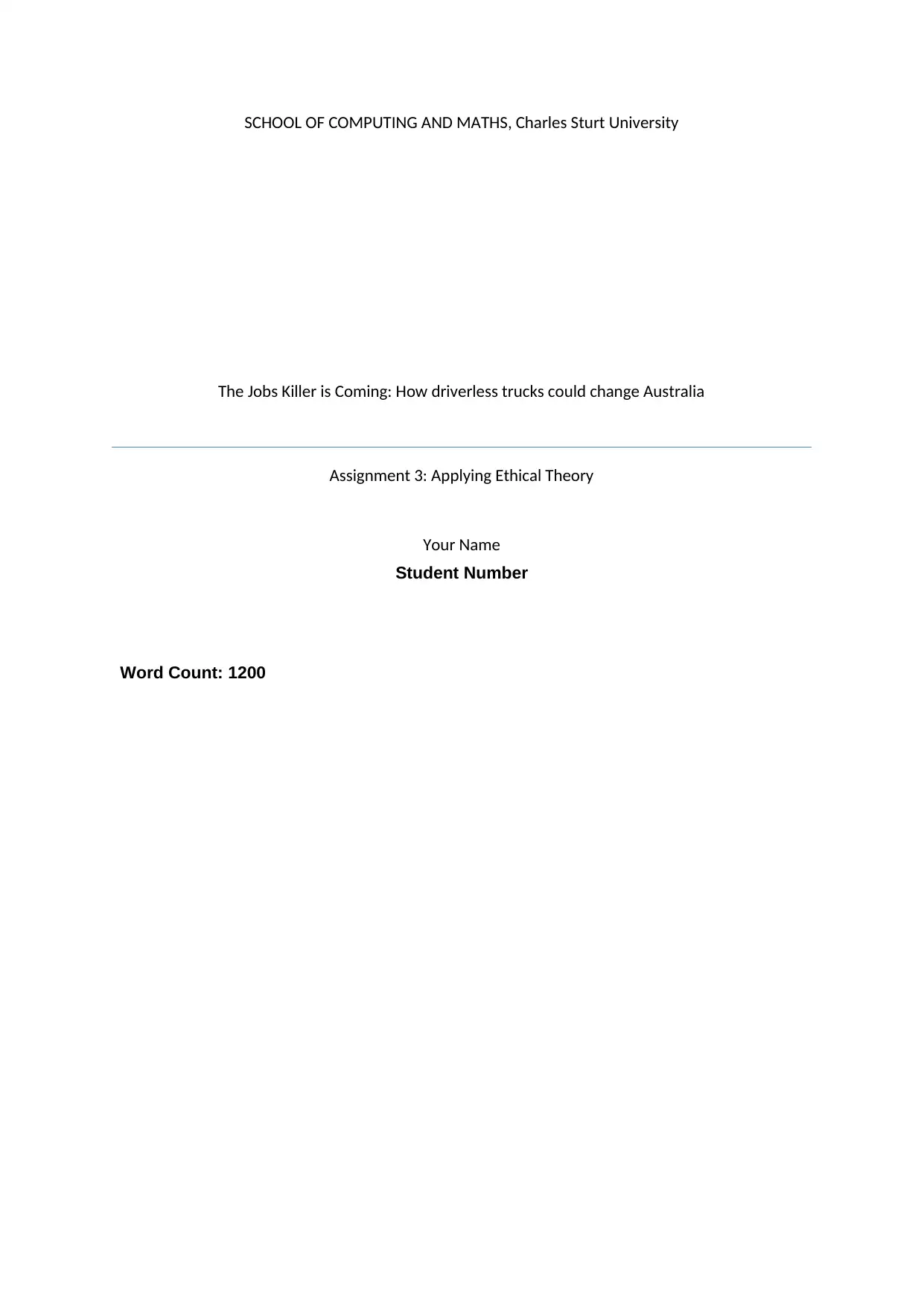
SCHOOL OF COMPUTING AND MATHS, Charles Sturt University
The Jobs Killer is Coming: How driverless trucks could change Australia
Assignment 3: Applying Ethical Theory
Your Name
Student Number
Word Count: 1200
The Jobs Killer is Coming: How driverless trucks could change Australia
Assignment 3: Applying Ethical Theory
Your Name
Student Number
Word Count: 1200
Paraphrase This Document
Need a fresh take? Get an instant paraphrase of this document with our AI Paraphraser
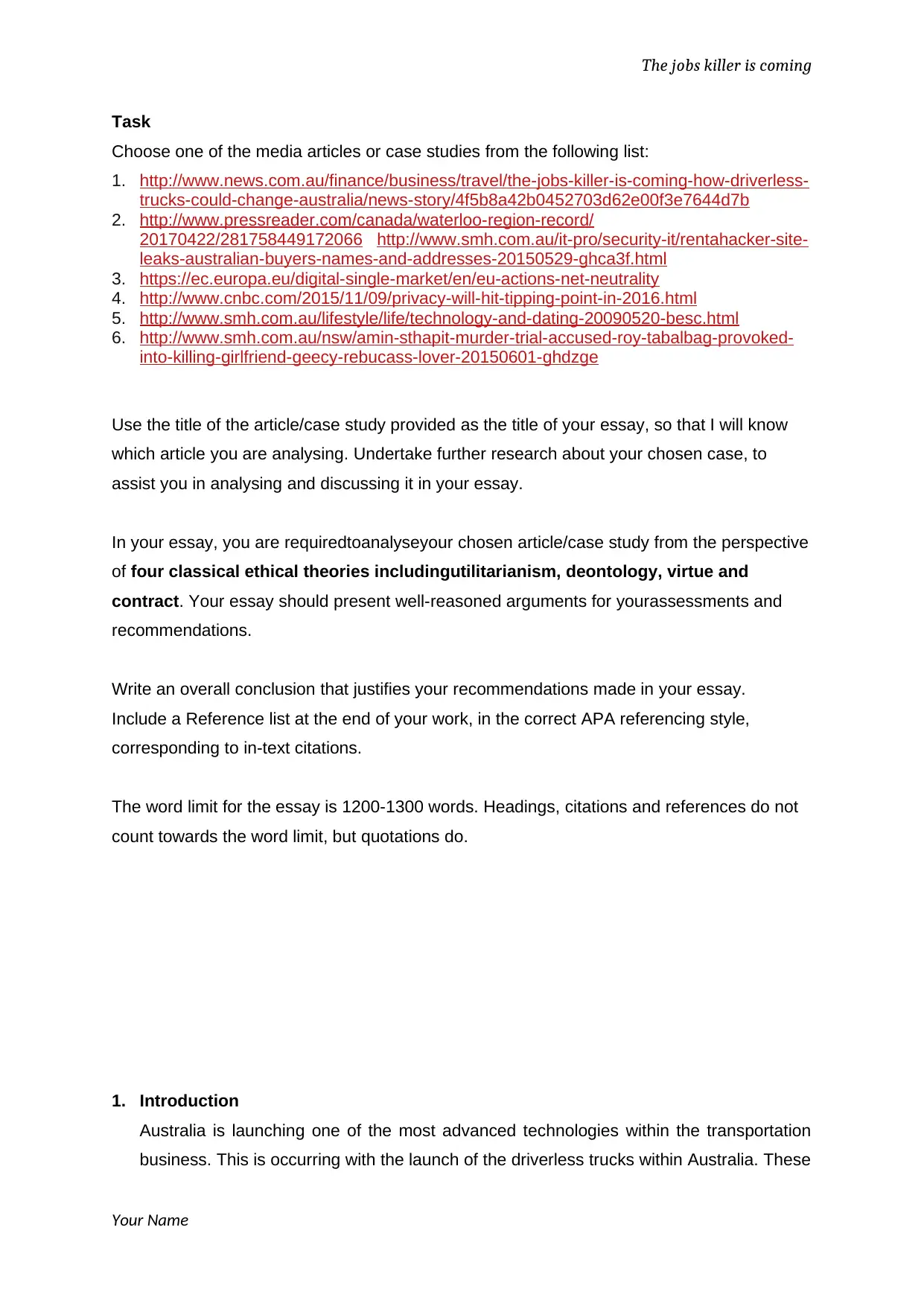
The jobs killer is coming
Task
Choose one of the media articles or case studies from the following list:
1. http://www.news.com.au/finance/business/travel/the-jobs-killer-is-coming-how-driverless-
trucks-could-change-australia/news-story/4f5b8a42b0452703d62e00f3e7644d7b
2. http://www.pressreader.com/canada/waterloo-region-record/
20170422/281758449172066 http://www.smh.com.au/it-pro/security-it/rentahacker-site-
leaks-australian-buyers-names-and-addresses-20150529-ghca3f.html
3. https://ec.europa.eu/digital-single-market/en/eu-actions-net-neutrality
4. http://www.cnbc.com/2015/11/09/privacy-will-hit-tipping-point-in-2016.html
5. http://www.smh.com.au/lifestyle/life/technology-and-dating-20090520-besc.html
6. http://www.smh.com.au/nsw/amin-sthapit-murder-trial-accused-roy-tabalbag-provoked-
into-killing-girlfriend-geecy-rebucass-lover-20150601-ghdzge
Use the title of the article/case study provided as the title of your essay, so that I will know
which article you are analysing. Undertake further research about your chosen case, to
assist you in analysing and discussing it in your essay.
In your essay, you are requiredtoanalyseyour chosen article/case study from the perspective
of four classical ethical theories includingutilitarianism, deontology, virtue and
contract. Your essay should present well-reasoned arguments for yourassessments and
recommendations.
Write an overall conclusion that justifies your recommendations made in your essay.
Include a Reference list at the end of your work, in the correct APA referencing style,
corresponding to in-text citations.
The word limit for the essay is 1200-1300 words. Headings, citations and references do not
count towards the word limit, but quotations do.
1. Introduction
Australia is launching one of the most advanced technologies within the transportation
business. This is occurring with the launch of the driverless trucks within Australia. These
Your Name
Task
Choose one of the media articles or case studies from the following list:
1. http://www.news.com.au/finance/business/travel/the-jobs-killer-is-coming-how-driverless-
trucks-could-change-australia/news-story/4f5b8a42b0452703d62e00f3e7644d7b
2. http://www.pressreader.com/canada/waterloo-region-record/
20170422/281758449172066 http://www.smh.com.au/it-pro/security-it/rentahacker-site-
leaks-australian-buyers-names-and-addresses-20150529-ghca3f.html
3. https://ec.europa.eu/digital-single-market/en/eu-actions-net-neutrality
4. http://www.cnbc.com/2015/11/09/privacy-will-hit-tipping-point-in-2016.html
5. http://www.smh.com.au/lifestyle/life/technology-and-dating-20090520-besc.html
6. http://www.smh.com.au/nsw/amin-sthapit-murder-trial-accused-roy-tabalbag-provoked-
into-killing-girlfriend-geecy-rebucass-lover-20150601-ghdzge
Use the title of the article/case study provided as the title of your essay, so that I will know
which article you are analysing. Undertake further research about your chosen case, to
assist you in analysing and discussing it in your essay.
In your essay, you are requiredtoanalyseyour chosen article/case study from the perspective
of four classical ethical theories includingutilitarianism, deontology, virtue and
contract. Your essay should present well-reasoned arguments for yourassessments and
recommendations.
Write an overall conclusion that justifies your recommendations made in your essay.
Include a Reference list at the end of your work, in the correct APA referencing style,
corresponding to in-text citations.
The word limit for the essay is 1200-1300 words. Headings, citations and references do not
count towards the word limit, but quotations do.
1. Introduction
Australia is launching one of the most advanced technologies within the transportation
business. This is occurring with the launch of the driverless trucks within Australia. These
Your Name
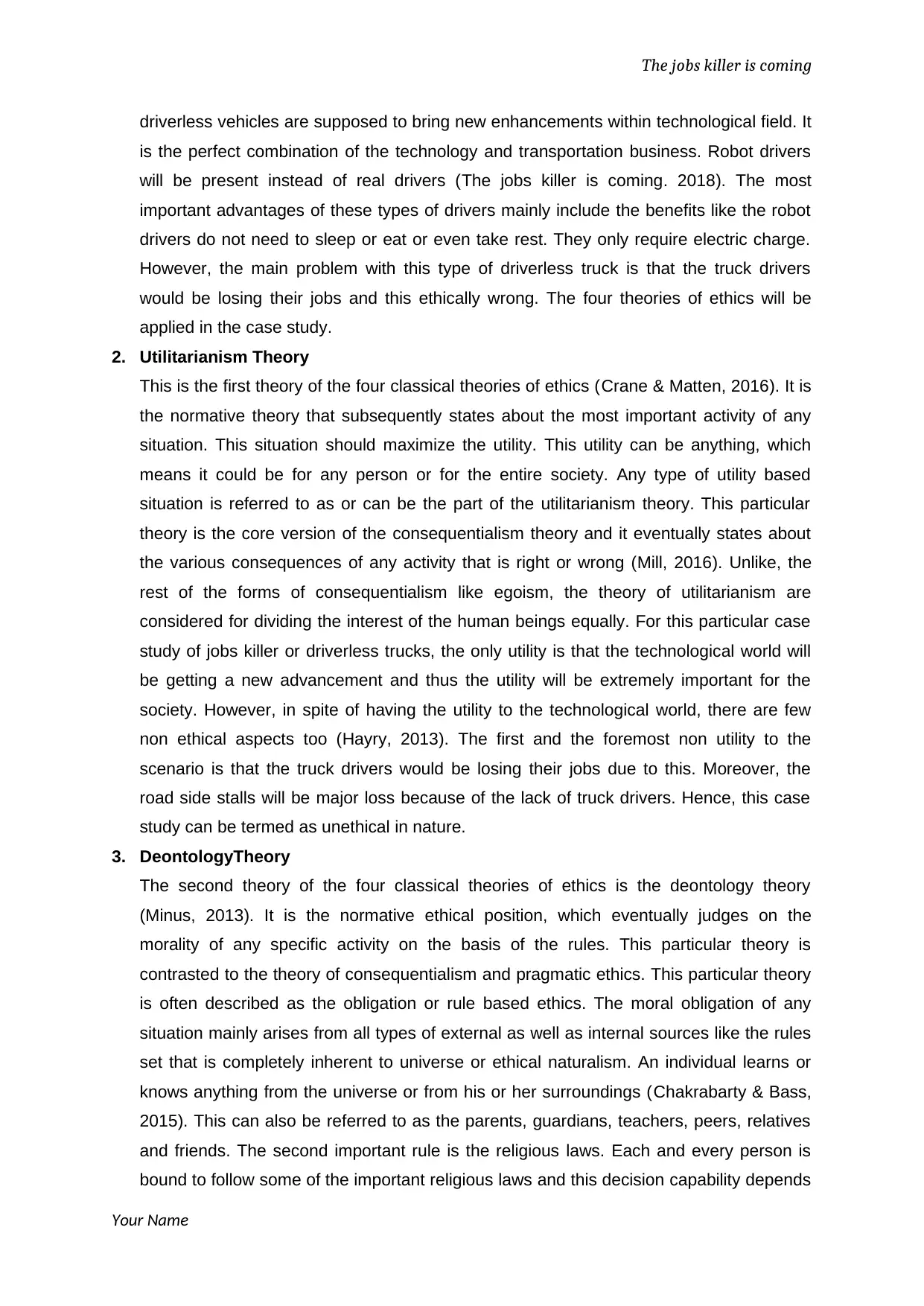
The jobs killer is coming
driverless vehicles are supposed to bring new enhancements within technological field. It
is the perfect combination of the technology and transportation business. Robot drivers
will be present instead of real drivers (The jobs killer is coming. 2018). The most
important advantages of these types of drivers mainly include the benefits like the robot
drivers do not need to sleep or eat or even take rest. They only require electric charge.
However, the main problem with this type of driverless truck is that the truck drivers
would be losing their jobs and this ethically wrong. The four theories of ethics will be
applied in the case study.
2. Utilitarianism Theory
This is the first theory of the four classical theories of ethics (Crane & Matten, 2016). It is
the normative theory that subsequently states about the most important activity of any
situation. This situation should maximize the utility. This utility can be anything, which
means it could be for any person or for the entire society. Any type of utility based
situation is referred to as or can be the part of the utilitarianism theory. This particular
theory is the core version of the consequentialism theory and it eventually states about
the various consequences of any activity that is right or wrong (Mill, 2016). Unlike, the
rest of the forms of consequentialism like egoism, the theory of utilitarianism are
considered for dividing the interest of the human beings equally. For this particular case
study of jobs killer or driverless trucks, the only utility is that the technological world will
be getting a new advancement and thus the utility will be extremely important for the
society. However, in spite of having the utility to the technological world, there are few
non ethical aspects too (Hayry, 2013). The first and the foremost non utility to the
scenario is that the truck drivers would be losing their jobs due to this. Moreover, the
road side stalls will be major loss because of the lack of truck drivers. Hence, this case
study can be termed as unethical in nature.
3. DeontologyTheory
The second theory of the four classical theories of ethics is the deontology theory
(Minus, 2013). It is the normative ethical position, which eventually judges on the
morality of any specific activity on the basis of the rules. This particular theory is
contrasted to the theory of consequentialism and pragmatic ethics. This particular theory
is often described as the obligation or rule based ethics. The moral obligation of any
situation mainly arises from all types of external as well as internal sources like the rules
set that is completely inherent to universe or ethical naturalism. An individual learns or
knows anything from the universe or from his or her surroundings (Chakrabarty & Bass,
2015). This can also be referred to as the parents, guardians, teachers, peers, relatives
and friends. The second important rule is the religious laws. Each and every person is
bound to follow some of the important religious laws and this decision capability depends
Your Name
driverless vehicles are supposed to bring new enhancements within technological field. It
is the perfect combination of the technology and transportation business. Robot drivers
will be present instead of real drivers (The jobs killer is coming. 2018). The most
important advantages of these types of drivers mainly include the benefits like the robot
drivers do not need to sleep or eat or even take rest. They only require electric charge.
However, the main problem with this type of driverless truck is that the truck drivers
would be losing their jobs and this ethically wrong. The four theories of ethics will be
applied in the case study.
2. Utilitarianism Theory
This is the first theory of the four classical theories of ethics (Crane & Matten, 2016). It is
the normative theory that subsequently states about the most important activity of any
situation. This situation should maximize the utility. This utility can be anything, which
means it could be for any person or for the entire society. Any type of utility based
situation is referred to as or can be the part of the utilitarianism theory. This particular
theory is the core version of the consequentialism theory and it eventually states about
the various consequences of any activity that is right or wrong (Mill, 2016). Unlike, the
rest of the forms of consequentialism like egoism, the theory of utilitarianism are
considered for dividing the interest of the human beings equally. For this particular case
study of jobs killer or driverless trucks, the only utility is that the technological world will
be getting a new advancement and thus the utility will be extremely important for the
society. However, in spite of having the utility to the technological world, there are few
non ethical aspects too (Hayry, 2013). The first and the foremost non utility to the
scenario is that the truck drivers would be losing their jobs due to this. Moreover, the
road side stalls will be major loss because of the lack of truck drivers. Hence, this case
study can be termed as unethical in nature.
3. DeontologyTheory
The second theory of the four classical theories of ethics is the deontology theory
(Minus, 2013). It is the normative ethical position, which eventually judges on the
morality of any specific activity on the basis of the rules. This particular theory is
contrasted to the theory of consequentialism and pragmatic ethics. This particular theory
is often described as the obligation or rule based ethics. The moral obligation of any
situation mainly arises from all types of external as well as internal sources like the rules
set that is completely inherent to universe or ethical naturalism. An individual learns or
knows anything from the universe or from his or her surroundings (Chakrabarty & Bass,
2015). This can also be referred to as the parents, guardians, teachers, peers, relatives
and friends. The second important rule is the religious laws. Each and every person is
bound to follow some of the important religious laws and this decision capability depends
Your Name
⊘ This is a preview!⊘
Do you want full access?
Subscribe today to unlock all pages.

Trusted by 1+ million students worldwide
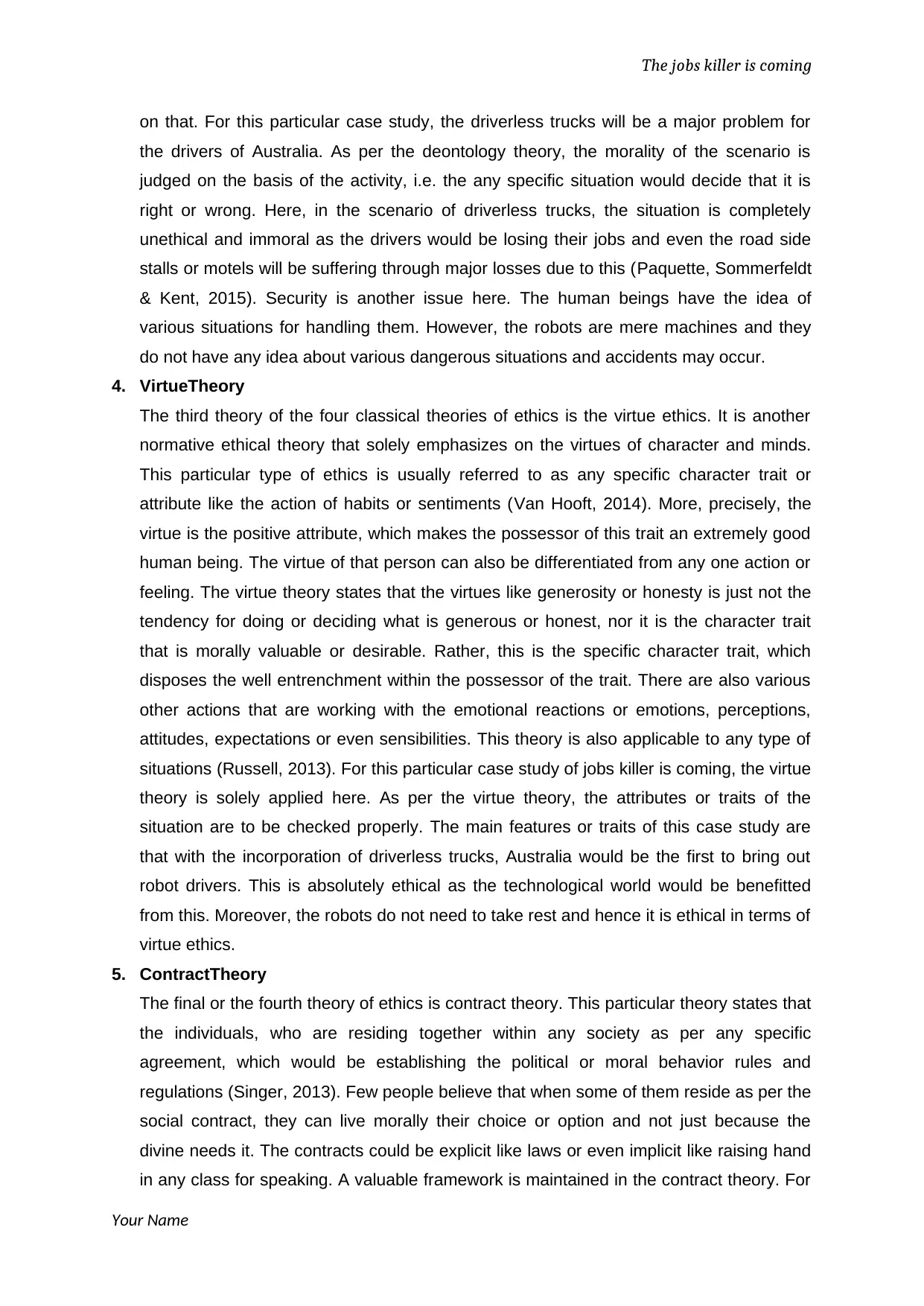
The jobs killer is coming
on that. For this particular case study, the driverless trucks will be a major problem for
the drivers of Australia. As per the deontology theory, the morality of the scenario is
judged on the basis of the activity, i.e. the any specific situation would decide that it is
right or wrong. Here, in the scenario of driverless trucks, the situation is completely
unethical and immoral as the drivers would be losing their jobs and even the road side
stalls or motels will be suffering through major losses due to this (Paquette, Sommerfeldt
& Kent, 2015). Security is another issue here. The human beings have the idea of
various situations for handling them. However, the robots are mere machines and they
do not have any idea about various dangerous situations and accidents may occur.
4. VirtueTheory
The third theory of the four classical theories of ethics is the virtue ethics. It is another
normative ethical theory that solely emphasizes on the virtues of character and minds.
This particular type of ethics is usually referred to as any specific character trait or
attribute like the action of habits or sentiments (Van Hooft, 2014). More, precisely, the
virtue is the positive attribute, which makes the possessor of this trait an extremely good
human being. The virtue of that person can also be differentiated from any one action or
feeling. The virtue theory states that the virtues like generosity or honesty is just not the
tendency for doing or deciding what is generous or honest, nor it is the character trait
that is morally valuable or desirable. Rather, this is the specific character trait, which
disposes the well entrenchment within the possessor of the trait. There are also various
other actions that are working with the emotional reactions or emotions, perceptions,
attitudes, expectations or even sensibilities. This theory is also applicable to any type of
situations (Russell, 2013). For this particular case study of jobs killer is coming, the virtue
theory is solely applied here. As per the virtue theory, the attributes or traits of the
situation are to be checked properly. The main features or traits of this case study are
that with the incorporation of driverless trucks, Australia would be the first to bring out
robot drivers. This is absolutely ethical as the technological world would be benefitted
from this. Moreover, the robots do not need to take rest and hence it is ethical in terms of
virtue ethics.
5. ContractTheory
The final or the fourth theory of ethics is contract theory. This particular theory states that
the individuals, who are residing together within any society as per any specific
agreement, which would be establishing the political or moral behavior rules and
regulations (Singer, 2013). Few people believe that when some of them reside as per the
social contract, they can live morally their choice or option and not just because the
divine needs it. The contracts could be explicit like laws or even implicit like raising hand
in any class for speaking. A valuable framework is maintained in the contract theory. For
Your Name
on that. For this particular case study, the driverless trucks will be a major problem for
the drivers of Australia. As per the deontology theory, the morality of the scenario is
judged on the basis of the activity, i.e. the any specific situation would decide that it is
right or wrong. Here, in the scenario of driverless trucks, the situation is completely
unethical and immoral as the drivers would be losing their jobs and even the road side
stalls or motels will be suffering through major losses due to this (Paquette, Sommerfeldt
& Kent, 2015). Security is another issue here. The human beings have the idea of
various situations for handling them. However, the robots are mere machines and they
do not have any idea about various dangerous situations and accidents may occur.
4. VirtueTheory
The third theory of the four classical theories of ethics is the virtue ethics. It is another
normative ethical theory that solely emphasizes on the virtues of character and minds.
This particular type of ethics is usually referred to as any specific character trait or
attribute like the action of habits or sentiments (Van Hooft, 2014). More, precisely, the
virtue is the positive attribute, which makes the possessor of this trait an extremely good
human being. The virtue of that person can also be differentiated from any one action or
feeling. The virtue theory states that the virtues like generosity or honesty is just not the
tendency for doing or deciding what is generous or honest, nor it is the character trait
that is morally valuable or desirable. Rather, this is the specific character trait, which
disposes the well entrenchment within the possessor of the trait. There are also various
other actions that are working with the emotional reactions or emotions, perceptions,
attitudes, expectations or even sensibilities. This theory is also applicable to any type of
situations (Russell, 2013). For this particular case study of jobs killer is coming, the virtue
theory is solely applied here. As per the virtue theory, the attributes or traits of the
situation are to be checked properly. The main features or traits of this case study are
that with the incorporation of driverless trucks, Australia would be the first to bring out
robot drivers. This is absolutely ethical as the technological world would be benefitted
from this. Moreover, the robots do not need to take rest and hence it is ethical in terms of
virtue ethics.
5. ContractTheory
The final or the fourth theory of ethics is contract theory. This particular theory states that
the individuals, who are residing together within any society as per any specific
agreement, which would be establishing the political or moral behavior rules and
regulations (Singer, 2013). Few people believe that when some of them reside as per the
social contract, they can live morally their choice or option and not just because the
divine needs it. The contracts could be explicit like laws or even implicit like raising hand
in any class for speaking. A valuable framework is maintained in the contract theory. For
Your Name
Paraphrase This Document
Need a fresh take? Get an instant paraphrase of this document with our AI Paraphraser
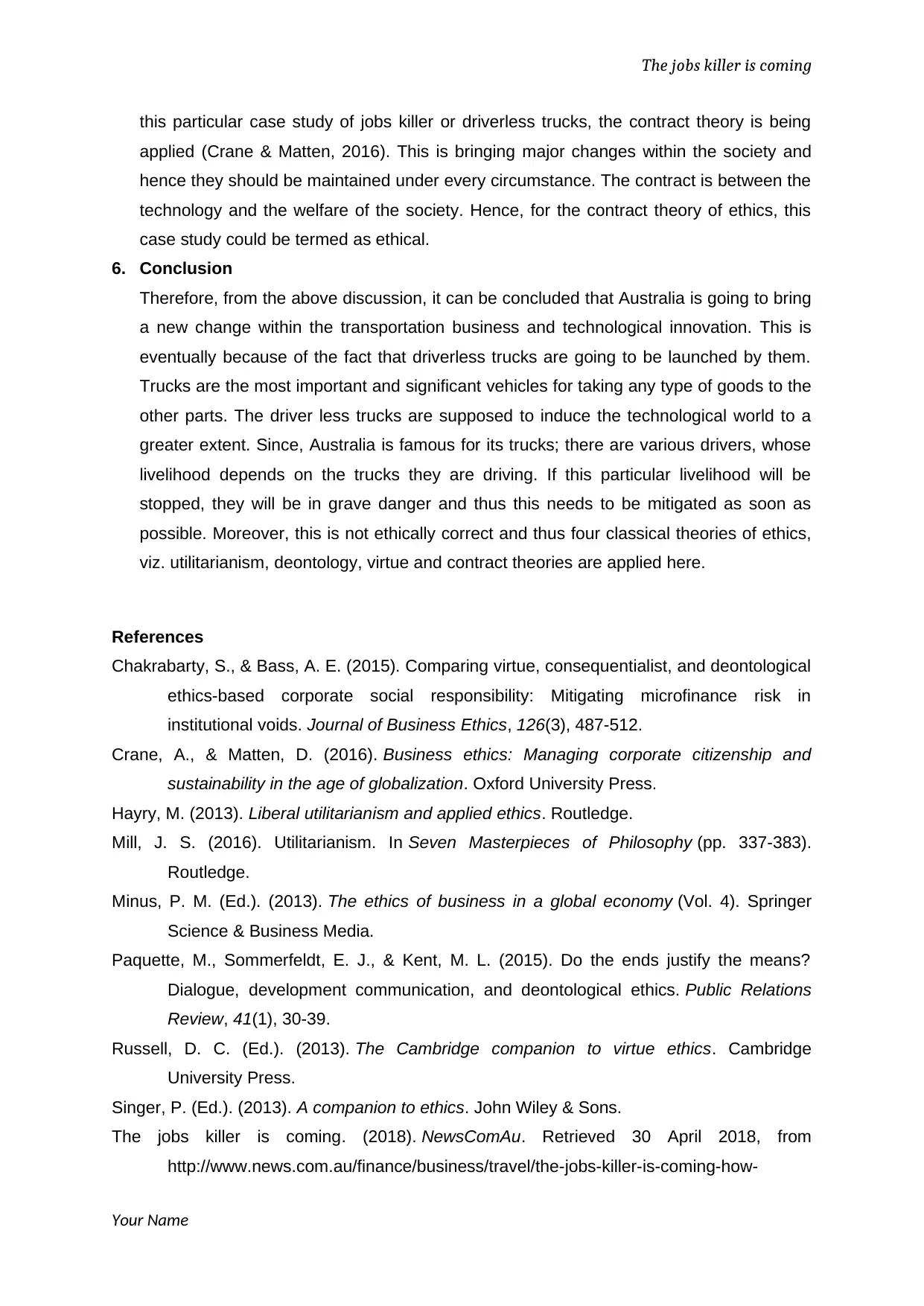
The jobs killer is coming
this particular case study of jobs killer or driverless trucks, the contract theory is being
applied (Crane & Matten, 2016). This is bringing major changes within the society and
hence they should be maintained under every circumstance. The contract is between the
technology and the welfare of the society. Hence, for the contract theory of ethics, this
case study could be termed as ethical.
6. Conclusion
Therefore, from the above discussion, it can be concluded that Australia is going to bring
a new change within the transportation business and technological innovation. This is
eventually because of the fact that driverless trucks are going to be launched by them.
Trucks are the most important and significant vehicles for taking any type of goods to the
other parts. The driver less trucks are supposed to induce the technological world to a
greater extent. Since, Australia is famous for its trucks; there are various drivers, whose
livelihood depends on the trucks they are driving. If this particular livelihood will be
stopped, they will be in grave danger and thus this needs to be mitigated as soon as
possible. Moreover, this is not ethically correct and thus four classical theories of ethics,
viz. utilitarianism, deontology, virtue and contract theories are applied here.
References
Chakrabarty, S., & Bass, A. E. (2015). Comparing virtue, consequentialist, and deontological
ethics-based corporate social responsibility: Mitigating microfinance risk in
institutional voids. Journal of Business Ethics, 126(3), 487-512.
Crane, A., & Matten, D. (2016). Business ethics: Managing corporate citizenship and
sustainability in the age of globalization. Oxford University Press.
Hayry, M. (2013). Liberal utilitarianism and applied ethics. Routledge.
Mill, J. S. (2016). Utilitarianism. In Seven Masterpieces of Philosophy (pp. 337-383).
Routledge.
Minus, P. M. (Ed.). (2013). The ethics of business in a global economy (Vol. 4). Springer
Science & Business Media.
Paquette, M., Sommerfeldt, E. J., & Kent, M. L. (2015). Do the ends justify the means?
Dialogue, development communication, and deontological ethics. Public Relations
Review, 41(1), 30-39.
Russell, D. C. (Ed.). (2013). The Cambridge companion to virtue ethics. Cambridge
University Press.
Singer, P. (Ed.). (2013). A companion to ethics. John Wiley & Sons.
The jobs killer is coming. (2018). NewsComAu. Retrieved 30 April 2018, from
http://www.news.com.au/finance/business/travel/the-jobs-killer-is-coming-how-
Your Name
this particular case study of jobs killer or driverless trucks, the contract theory is being
applied (Crane & Matten, 2016). This is bringing major changes within the society and
hence they should be maintained under every circumstance. The contract is between the
technology and the welfare of the society. Hence, for the contract theory of ethics, this
case study could be termed as ethical.
6. Conclusion
Therefore, from the above discussion, it can be concluded that Australia is going to bring
a new change within the transportation business and technological innovation. This is
eventually because of the fact that driverless trucks are going to be launched by them.
Trucks are the most important and significant vehicles for taking any type of goods to the
other parts. The driver less trucks are supposed to induce the technological world to a
greater extent. Since, Australia is famous for its trucks; there are various drivers, whose
livelihood depends on the trucks they are driving. If this particular livelihood will be
stopped, they will be in grave danger and thus this needs to be mitigated as soon as
possible. Moreover, this is not ethically correct and thus four classical theories of ethics,
viz. utilitarianism, deontology, virtue and contract theories are applied here.
References
Chakrabarty, S., & Bass, A. E. (2015). Comparing virtue, consequentialist, and deontological
ethics-based corporate social responsibility: Mitigating microfinance risk in
institutional voids. Journal of Business Ethics, 126(3), 487-512.
Crane, A., & Matten, D. (2016). Business ethics: Managing corporate citizenship and
sustainability in the age of globalization. Oxford University Press.
Hayry, M. (2013). Liberal utilitarianism and applied ethics. Routledge.
Mill, J. S. (2016). Utilitarianism. In Seven Masterpieces of Philosophy (pp. 337-383).
Routledge.
Minus, P. M. (Ed.). (2013). The ethics of business in a global economy (Vol. 4). Springer
Science & Business Media.
Paquette, M., Sommerfeldt, E. J., & Kent, M. L. (2015). Do the ends justify the means?
Dialogue, development communication, and deontological ethics. Public Relations
Review, 41(1), 30-39.
Russell, D. C. (Ed.). (2013). The Cambridge companion to virtue ethics. Cambridge
University Press.
Singer, P. (Ed.). (2013). A companion to ethics. John Wiley & Sons.
The jobs killer is coming. (2018). NewsComAu. Retrieved 30 April 2018, from
http://www.news.com.au/finance/business/travel/the-jobs-killer-is-coming-how-
Your Name
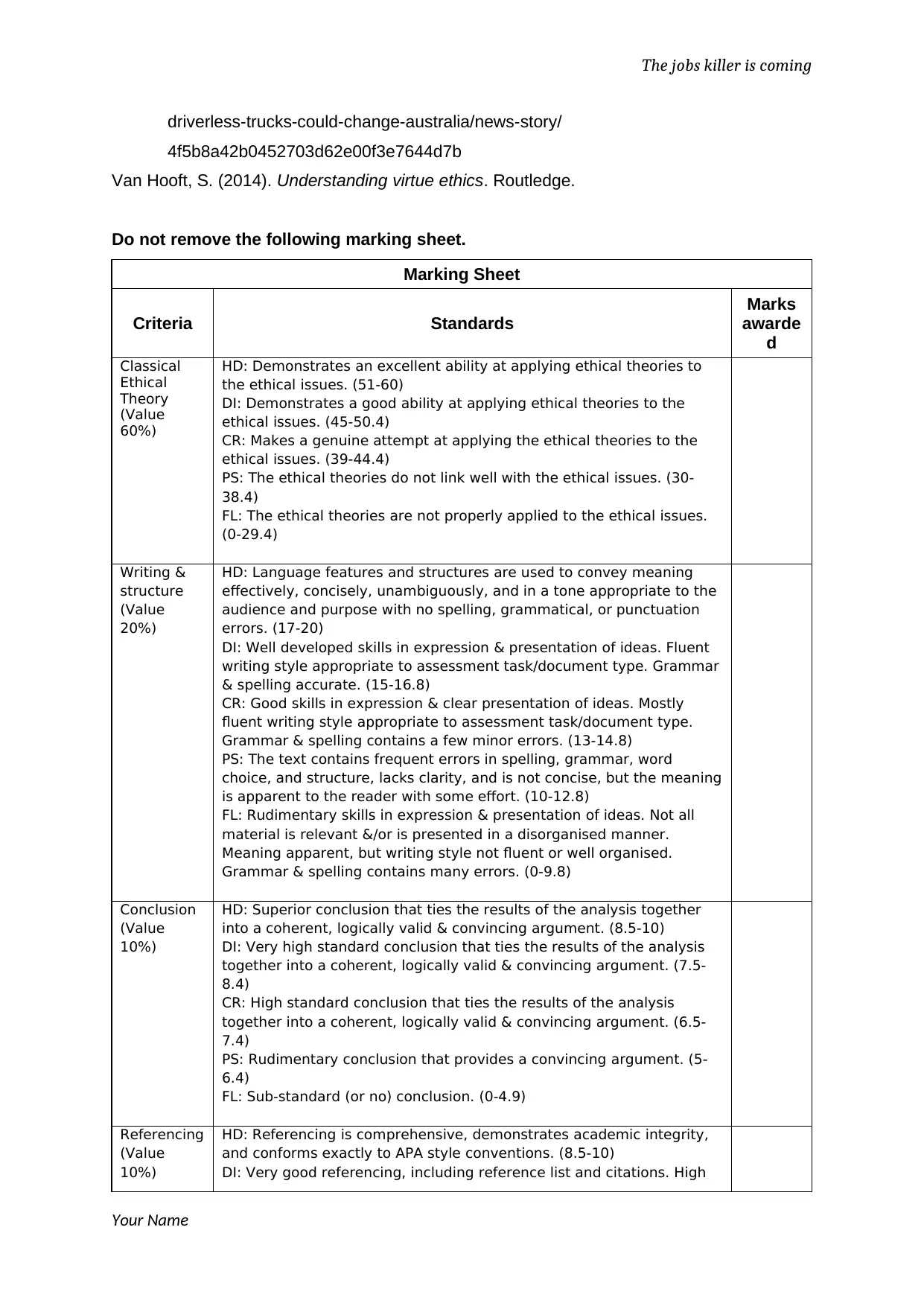
The jobs killer is coming
driverless-trucks-could-change-australia/news-story/
4f5b8a42b0452703d62e00f3e7644d7b
Van Hooft, S. (2014). Understanding virtue ethics. Routledge.
Do not remove the following marking sheet.
Marking Sheet
Criteria Standards
Marks
awarde
d
Classical
Ethical
Theory
(Value
60%)
HD: Demonstrates an excellent ability at applying ethical theories to
the ethical issues. (51-60)
DI: Demonstrates a good ability at applying ethical theories to the
ethical issues. (45-50.4)
CR: Makes a genuine attempt at applying the ethical theories to the
ethical issues. (39-44.4)
PS: The ethical theories do not link well with the ethical issues. (30-
38.4)
FL: The ethical theories are not properly applied to the ethical issues.
(0-29.4)
Writing &
structure
(Value
20%)
HD: Language features and structures are used to convey meaning
effectively, concisely, unambiguously, and in a tone appropriate to the
audience and purpose with no spelling, grammatical, or punctuation
errors. (17-20)
DI: Well developed skills in expression & presentation of ideas. Fluent
writing style appropriate to assessment task/document type. Grammar
& spelling accurate. (15-16.8)
CR: Good skills in expression & clear presentation of ideas. Mostly
fluent writing style appropriate to assessment task/document type.
Grammar & spelling contains a few minor errors. (13-14.8)
PS: The text contains frequent errors in spelling, grammar, word
choice, and structure, lacks clarity, and is not concise, but the meaning
is apparent to the reader with some effort. (10-12.8)
FL: Rudimentary skills in expression & presentation of ideas. Not all
material is relevant &/or is presented in a disorganised manner.
Meaning apparent, but writing style not fluent or well organised.
Grammar & spelling contains many errors. (0-9.8)
Conclusion
(Value
10%)
HD: Superior conclusion that ties the results of the analysis together
into a coherent, logically valid & convincing argument. (8.5-10)
DI: Very high standard conclusion that ties the results of the analysis
together into a coherent, logically valid & convincing argument. (7.5-
8.4)
CR: High standard conclusion that ties the results of the analysis
together into a coherent, logically valid & convincing argument. (6.5-
7.4)
PS: Rudimentary conclusion that provides a convincing argument. (5-
6.4)
FL: Sub-standard (or no) conclusion. (0-4.9)
Referencing
(Value
10%)
HD: Referencing is comprehensive, demonstrates academic integrity,
and conforms exactly to APA style conventions. (8.5-10)
DI: Very good referencing, including reference list and citations. High
Your Name
driverless-trucks-could-change-australia/news-story/
4f5b8a42b0452703d62e00f3e7644d7b
Van Hooft, S. (2014). Understanding virtue ethics. Routledge.
Do not remove the following marking sheet.
Marking Sheet
Criteria Standards
Marks
awarde
d
Classical
Ethical
Theory
(Value
60%)
HD: Demonstrates an excellent ability at applying ethical theories to
the ethical issues. (51-60)
DI: Demonstrates a good ability at applying ethical theories to the
ethical issues. (45-50.4)
CR: Makes a genuine attempt at applying the ethical theories to the
ethical issues. (39-44.4)
PS: The ethical theories do not link well with the ethical issues. (30-
38.4)
FL: The ethical theories are not properly applied to the ethical issues.
(0-29.4)
Writing &
structure
(Value
20%)
HD: Language features and structures are used to convey meaning
effectively, concisely, unambiguously, and in a tone appropriate to the
audience and purpose with no spelling, grammatical, or punctuation
errors. (17-20)
DI: Well developed skills in expression & presentation of ideas. Fluent
writing style appropriate to assessment task/document type. Grammar
& spelling accurate. (15-16.8)
CR: Good skills in expression & clear presentation of ideas. Mostly
fluent writing style appropriate to assessment task/document type.
Grammar & spelling contains a few minor errors. (13-14.8)
PS: The text contains frequent errors in spelling, grammar, word
choice, and structure, lacks clarity, and is not concise, but the meaning
is apparent to the reader with some effort. (10-12.8)
FL: Rudimentary skills in expression & presentation of ideas. Not all
material is relevant &/or is presented in a disorganised manner.
Meaning apparent, but writing style not fluent or well organised.
Grammar & spelling contains many errors. (0-9.8)
Conclusion
(Value
10%)
HD: Superior conclusion that ties the results of the analysis together
into a coherent, logically valid & convincing argument. (8.5-10)
DI: Very high standard conclusion that ties the results of the analysis
together into a coherent, logically valid & convincing argument. (7.5-
8.4)
CR: High standard conclusion that ties the results of the analysis
together into a coherent, logically valid & convincing argument. (6.5-
7.4)
PS: Rudimentary conclusion that provides a convincing argument. (5-
6.4)
FL: Sub-standard (or no) conclusion. (0-4.9)
Referencing
(Value
10%)
HD: Referencing is comprehensive, demonstrates academic integrity,
and conforms exactly to APA style conventions. (8.5-10)
DI: Very good referencing, including reference list and citations. High
Your Name
⊘ This is a preview!⊘
Do you want full access?
Subscribe today to unlock all pages.

Trusted by 1+ million students worldwide
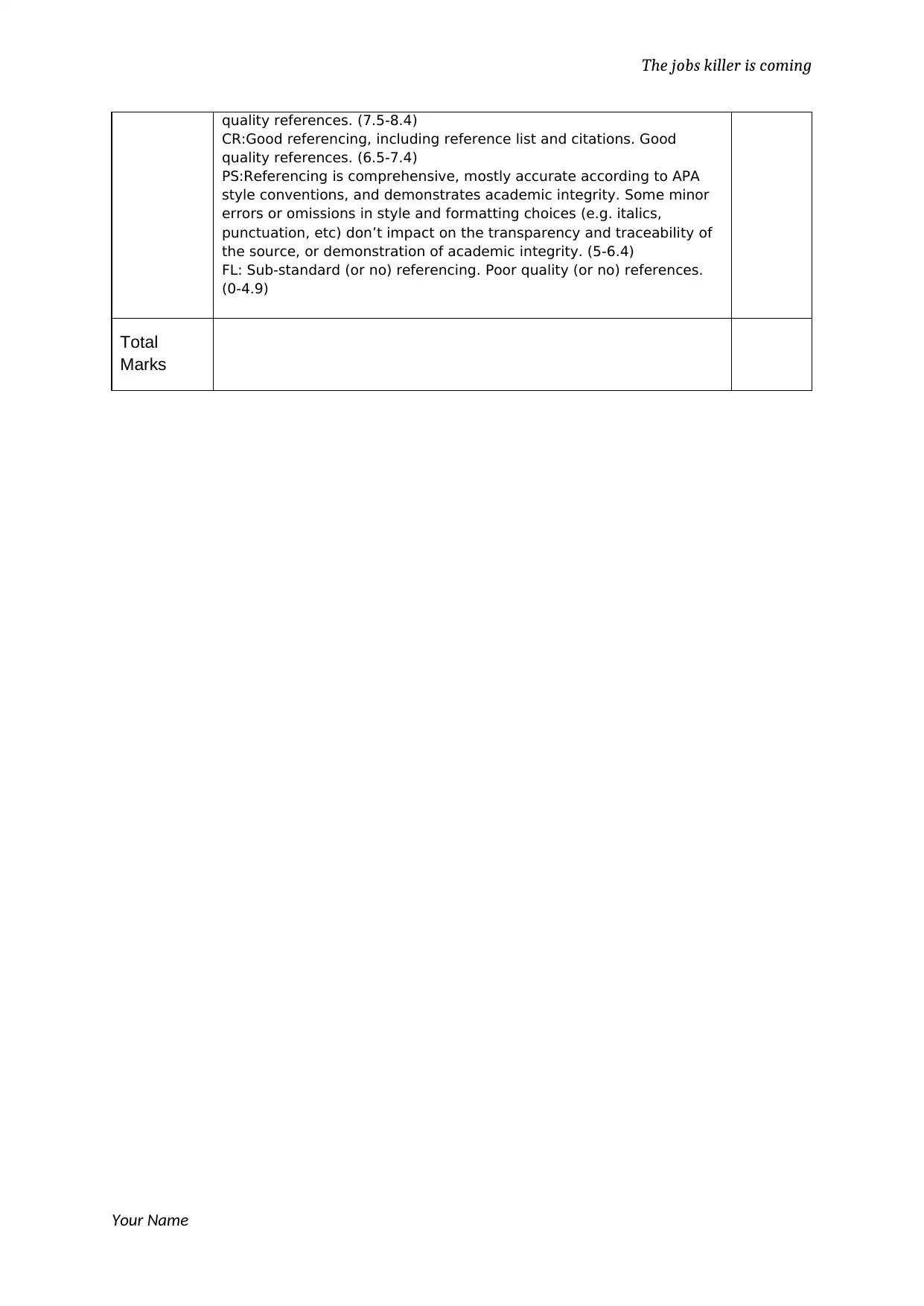
The jobs killer is coming
quality references. (7.5-8.4)
CR:Good referencing, including reference list and citations. Good
quality references. (6.5-7.4)
PS:Referencing is comprehensive, mostly accurate according to APA
style conventions, and demonstrates academic integrity. Some minor
errors or omissions in style and formatting choices (e.g. italics,
punctuation, etc) don’t impact on the transparency and traceability of
the source, or demonstration of academic integrity. (5-6.4)
FL: Sub-standard (or no) referencing. Poor quality (or no) references.
(0-4.9)
Total
Marks
Your Name
quality references. (7.5-8.4)
CR:Good referencing, including reference list and citations. Good
quality references. (6.5-7.4)
PS:Referencing is comprehensive, mostly accurate according to APA
style conventions, and demonstrates academic integrity. Some minor
errors or omissions in style and formatting choices (e.g. italics,
punctuation, etc) don’t impact on the transparency and traceability of
the source, or demonstration of academic integrity. (5-6.4)
FL: Sub-standard (or no) referencing. Poor quality (or no) references.
(0-4.9)
Total
Marks
Your Name
1 out of 7
Related Documents
Your All-in-One AI-Powered Toolkit for Academic Success.
+13062052269
info@desklib.com
Available 24*7 on WhatsApp / Email
![[object Object]](/_next/static/media/star-bottom.7253800d.svg)
Unlock your academic potential
Copyright © 2020–2025 A2Z Services. All Rights Reserved. Developed and managed by ZUCOL.





